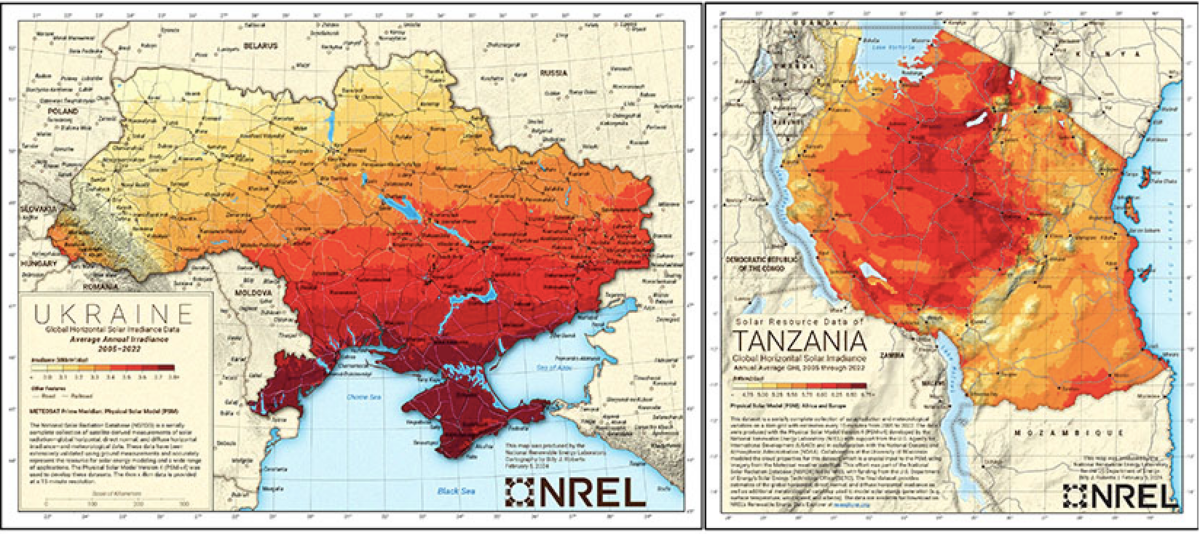NREL has released a new high-resolution solar data set on its publicly available geospatial analysis tool, the Renewable Energy Data Explorer. It covers Africa, Eastern Europe, and the Middle East.
NREL says the data will help advance power system planning and solar energy deployment in the three areas and is tailored to the needs of stakeholders in energy sectors.
It said that the project was driven by challenges facing Tanzania and Ukraine, two countries where the availability of reliable, long-term resource data has proved a barrier in accelerating the deployment of renewable energy.
To produce the data set, researchers compiled data sources covering Africa, Europe, and the Middle East from 2005 to 2022. They used imagery captured every 15 minutes by EU Meteosat geostationary weather satellites, while partners at the University of Wisconsin modeled key factors including cloud cover and composition. NREL also integrated satellite data from NASA to estimate the solar irradiance reaching the surface on a 4 km grid.
The cloud properties were run through NREL's radiative transfer model on the laboratory's supercomputer, pixel by pixel, time step by time step, to create a high-resolution grid over the 18-year period of the final data set.
NREL says the data gives solar developers and potential electricity purchasers estimates for the expected amount of electricity generated for a given percentage of years of a project, which informs the exceedance probability.
Popular content
“Those numbers are important because they're used to inform project risk and help secure financing. To calculate exceedance probabilities, you need the long-term record of the solar resource to represent interannual variability, and this feeds into project bankability,” said Geospatial Data Science Group Manager Galen Maclaurin. “It provides an assessment of the generation potential and its uncertainty, and thus informs the project risk for a financier or a bank.”
In Ukraine, it is hoped the dataset will help to rebuild and decentralize the grid following Russia’s invasion. The data set is expected to give planners and developers a clear picture of where they could competitively build photovoltaics.
“It's an enabler to help planners, utilities, and developers accelerate their adoption of renewables because they can skip the step of doing a site-by-site assessment of the resource,” says NREL's Ukraine program lead Ilya Chernyakhovskiy.
In Tanzania, where reliable and detailed data has been historically difficult to access, it is expected the data set can help the country achieve its renewable energy goals.
“This is a big deal to have a solar data set that we can trust for Africa; it's going to be a game changer,” said NREL's Tanzania technical lead Kwami Sedzro. “Providing these data is going to be very helpful for the industry as a whole in Africa, because then people can be motivated to invest in the technology.”
This content is protected by copyright and may not be reused. If you want to cooperate with us and would like to reuse some of our content, please contact: editors@pv-magazine.com.


2 comments
By submitting this form you agree to pv magazine using your data for the purposes of publishing your comment.
Your personal data will only be disclosed or otherwise transmitted to third parties for the purposes of spam filtering or if this is necessary for technical maintenance of the website. Any other transfer to third parties will not take place unless this is justified on the basis of applicable data protection regulations or if pv magazine is legally obliged to do so.
You may revoke this consent at any time with effect for the future, in which case your personal data will be deleted immediately. Otherwise, your data will be deleted if pv magazine has processed your request or the purpose of data storage is fulfilled.
Further information on data privacy can be found in our Data Protection Policy.